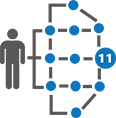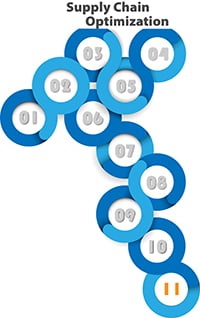April 7, 2014 | Supply Chain Management
Supply Chain Visibility

|
Written by: Terry Weiner The following post is #11 and is the final blog on Supply Chain Optimization. Our goal for the entire series of posts was to provide an overview of the Supply Chain Optimization process and highlight some of the concepts and tools that are part of the Manufacturing Extension Partnership (MEP) Supply Chain Optimization Initiative. Click here to read earlier posts. |
 Supply Chain Visibility
Supply Chain Visibility
In most of the surveys we see about
supply chain challenges, supply
 chain visibility consistently ranks near the top of the list. Most organizations don’t have visibility of key supply and demand data from more than one tier up or down from their own position.
chain visibility consistently ranks near the top of the list. Most organizations don’t have visibility of key supply and demand data from more than one tier up or down from their own position.
In the ideal world of a demand driven supply chain, flow of product to the end customer and from the furthest upstream supplier would be synchronized to provide a smooth and efficient flow of material that is also responsive to demand variation.
The goal of supply chain visibility is to reduce business and supply chain risk, while improving lead times and performance, and identifying shortage and quality problems along the supply chain.
So why is this ideal state so difficult to achieve? To understand the problem we need to first look at the real world as it exists today. To begin with, information in most organization exists in silos. The sales department has its projections and budget, production has its production schedules, buyers have supplier cost and delivery schedule data, etc. The focus of this fragmentation of data is designed to serve the purposes of the individual departments in the organization instead of that of the entire supply chain. In addition, each of the suppliers and customers has their own silos of information, not commonly shared with other supply chain partners.
In a recent Gartner research paper (April 2013) the goal of supply chain visibility was described as follows -
"The aim of end-to-end supply chain visibility (E2ESCV) is to provide controlled access and transparency to accurate, timely and complete events and data — transactions, content and relevant supply chain information — within and across organizations and services operating supply chains"
So how do we get there from here?
A concept that has gained a lot of discussion lately is that of the supply chain control tower. The control tower makes key data available to the partners in a supply chain that facilitates coordination of customer demand with supplier response. For a supply chain control tower to transform available data into usable information development is required in three areas:
- Processes – Processes need to become more collaborative, with data sharing and planning being done across departments as well as between organizations. Coordination of sales projections and the supply chain can assist in helping suppliers to anticipate future demand. Organizations need to develop specific data requirements that can be shared between partners in the supply chain to make demand planning possible. Risk management needs to be implemented to mitigate the potential of supply chain interruptions.
- Relationships – Information must be shared across processes not only within the organization within the functional silos such as planning, sourcing, production, and delivery, but also across business functions and outside the enterprise, providing a real end-to-end process view to all supply chain partners. Collaboration between tiers is needed. This requires a level of trust between tiers that still needs to be developed. Information has to be shared across the supply chain in order to connect partners in the network and provide a real end-to-end process view.
- Technology – A major challenge in the sharing of information between tiers is the problem of passing data between disparate information systems. How do you connect a company with an enterprise-wide ERP system with a supplier who manages their business on a spreadsheet?
Innovations such as cloud computing, and data collection and analysis software are now making supply chain control towers possible. Once a dataset is designed to give supply chain partners the information they need for sensing and shaping supply chain demand, the data can be communicated up and down the supply chain for analysis and planning.
The real time end-to-end data that the supply chain control tower provides enables companies to manage demand signals more accurately to reduce inventory levels, answer customers’ requests faster and more accurately, and smooth the effects of demand variation.
Terry Weiner is a Senior Consultant with California Manufacturing Technology Consulting® (CMTC). He has over 20 years experience in process improvements, quality management implementation and supply chain optimization.


Leave a Comment